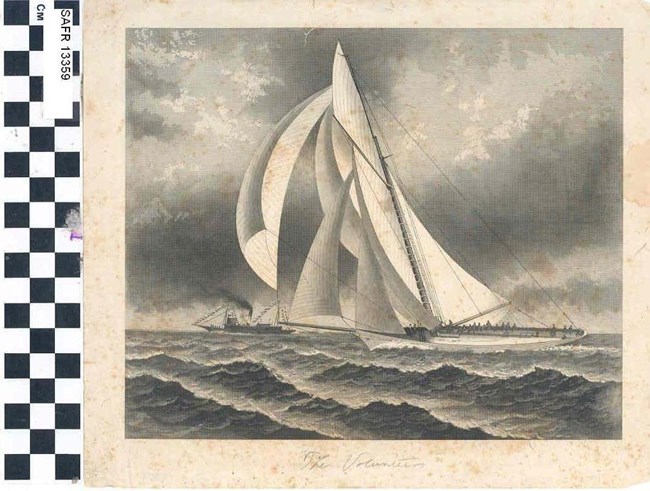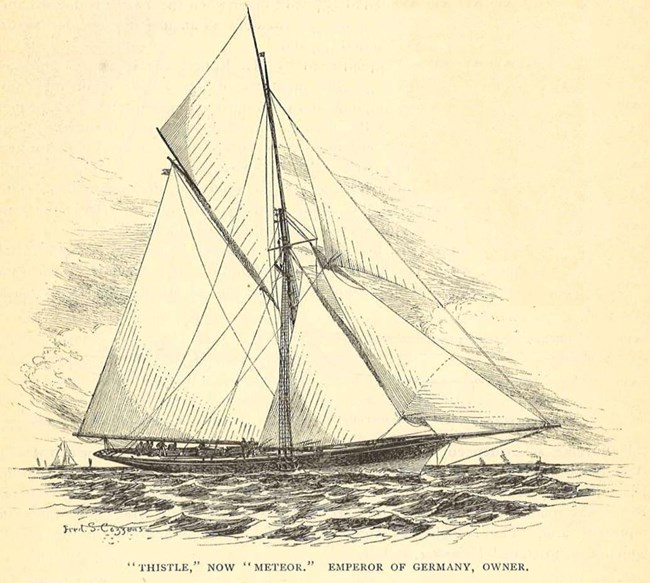
This powerful image captures the very essence of yacht racing in the late nineteenth and early twentieth centuries, a time when "practically the entire civilized world [was] eagerly scanning every item regarding the coming races. Wars, accidents, and even the doings in Washington become back page news compared to the international races. It's the one time when yacht racing is on everyone's tongue" [William --, "Editorial," The Rudder (1937) 11]. When the Volunteer defended the America's Cup in 1887, Americans flocked to New York, lining the shoreline along the entire course and booking passage on the numerous excursion vessels that shadowed the racers, in an attempt to participate, if only from a distance, in yacht racing's grandest event. The decisive win in 1851 of the U.S. yacht America in the Royal Yacht Squadron 100 Guinea Cup race sponsored by the Royal Yacht Club during the closing days of the World's Fair held in London, brought the prize that came to be known as the America's Cup from England to New York and yachting to the forefront of American sports. Nearly twenty years passed before the first challenge was issued by the English to reclaim the 100 guinea cup. Over the ensuing years other challengers from the British Isles and Canada tried to reclaim the cup and with each successive challenge and win by the Americans, yachting gained in popularity. In 1886, Vice Commodore James Bell of the Royal Clyde Yacht Club issued a challenge for the America's Cup and proposed the race be held in 1887. Bell contracted with George Watson of Glasgow to build the challenger, Thistle, under a cloak of great secrecy. The Thistle's length at the waterline was 89.46 feet with an overall length of 108.5 feet. Her breadth was 20.3 feet and her depth was 14.7 feet. The Thistle's greatest sailing strength was her ability to move rapidly through water in moderate weather and, based on her performance during her trial races, when she defeated all-comers with ease, English yachtsmen confidently predicted a successful cup-hunting mission for the yacht against the American defender. Upon accepting Vice Commodore Bell's challenge, American yachtsmen began determining which yacht would defend the cup. The honor went to the yacht Volunteer, designed by Edward Burgess and built in 66 days at the Pusey & Jones Shipbuilding Company in Wilmington, Delaware. Her design included evolutionary improvements to the design of the Mayflower, the previous defender and champion of the America's Cup, that gave Volunteer "an extremely sharp angle between her forefoot and the lowest line of the keel, great depth aft, and unusually long overhang and a sharp sheer [A.J. Kenealy, Yacht Races for the America's Cup 1851-1893 (NY: The Outing Company, Limited, 1894), 108]. 
Upon accepting Vice Commodore Bell's challenge, American yachtsmen began determining which yacht would defend the cup. The honor went to the yacht Volunteer, designed by Edward Burgess and built in 66 days at the Pusey & Jones Shipbuilding Company in Wilmington, Delaware. Her design included evolutionary improvements to the design of the Mayflower, the previous defender and champion of the America's Cup, that gave Volunteer "an extremely sharp angle between her forefoot and the lowest line of the keel, great depth aft, and unusually long overhang and a sharp sheer [A.J. Kenealy, Yacht Races for the America's Cup 1851-1893 (NY: The Outing Company, Limited, 1894), 108]. 
Volunteer was 106 feet overall (six feet longer than Mayflower) with a waterline length of 85 feet 6 inches. Her breadth measured 23 feet 2 inches and her depth was 10 feet. During trial races between the Volunteer and Mayflower, it was reported that, while the Mayflower was handled very skillfully, she had neither the speed nor the ability displayed by the Volunteer. 
|
Last updated: March 1, 2015
